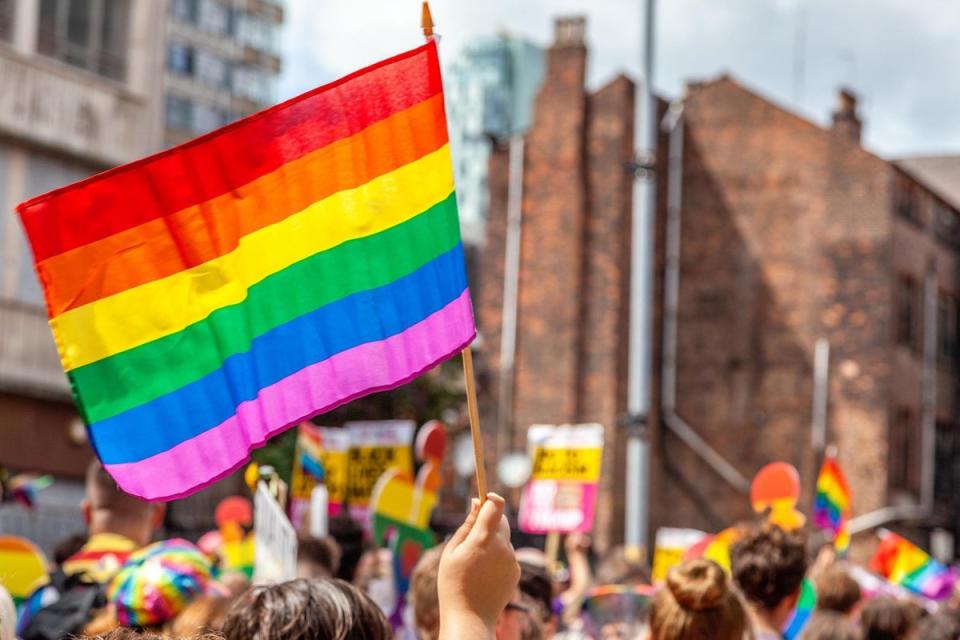What do all the letters in LGBTQIA+ stand for?

Every June, members of the LGBT+ community celebrate Pride month in honour of the 1969 Stonewall uprising.
Typically, the month-long celebration is marked with parades and other celebrations, which attract millions of people in support of the LGBT community annually.
As awareness around the LGBT community has grown, so have the words used to describe different sexualities - with the language surrounding the spectrum of sexuality constantly evolving.
In recent years, the queer community has most commonly been referred to as the LGBT or LGBTQ community.
The acronym is also seen with a + sign at the end, which has its own significance.
Although not everyone in the queer community chooses to subscribe to specific labels, this is the most commonly used list of terms to refer to non-hetero sexualities.
LGBT is an initialism for lesbian, gay, bisexual and transgender. The acronym, which is often used as a blanket term to refer to the queer community, first became popular in the 1980s when it replaced the term gay to reference all those who do not identify as heterosexual.
It has since grown to LGBTTQQIAAP, to encompass numerous other sexual and gender identities.
What do the additional letters mean?
As understanding about sexuality and sexual identity has grown, a fifth letter has been added to the acronym with increasing frequency.
The Q often placed at the end of LGBT refers to queer or questioning, according to the Lesbian, Gay, Bisexual and Transgender Community Center.
Previously, Cleo Anderson, an employee of the LGBT rights group GLAAD told USAToday: “Queer is anything that exists outside of the dominant narrative. Queer means that you are one of those letters [LGBT], but you could be all of those letters and not knowing is okay.”
Anderson also said the Q is useful because it “can be used to convey the nuances of race and culture and how that intersects with an individual’s gender identity and sexual orientation”.
The acronym has also expanded to include an I and an A at the end, making it LGBTQIA.
New York celebrates Pride on Stonewall anniversary: In pictures
New York celebrates Pride on Stonewall anniversary: In pictures
1/15
People dressed as flamingoes take part in the New York Pride March on June 30
Getty
2/15
People on stilts march in the New York Pride Parade on June 30
Reuters
3/15
People stand at the roadside during the New York Pride March on June 30
Getty
4/15
A participant wears a hat depicting the Stonewall Inn during the New York Pride March on June 30
AFP/Getty
5/15
Acitvists march in the New York Pride March on June 30
Reuters
6/15
People take part in the New York Pride Parade on June 30
Getty
7/15
A woman dressed as the Statue of Liberty takes part in the New York Pride March on June 30
Getty
8/15
People take part in the New York Pride Parade on June 30
Getty
9/15
Marchers kiss during the New York Pride March on June 30
Reuters
10/15
A marcher wears a “Mueller report” during the New York Pride March on June 30
Reuters
11/15
A couple kiss during the New York Pride March on June 30
AFP/Getty
12/15
A couple kiss during the New York Pride March on June 30
Getty
13/15
An infant dressed as a unicorn takes part in the New York Pride March on June 30
AFP/Getty
14/15
A person waves a rainbow flag in the New York Pride Parade on June 30
AFP/Getty
15/15
People carry a rainbow flag in the New York Pride Parade on June 30
Getty
According to the LGBT youth support group OK2BME, the I stands for intersex.
Intersex is an umbrella term “that describes bodies that fall outside the strict male/female binary”, according to Planned Parenthood.
The A on the end of the acronym also has multiple meanings, used to represent those who identify as asexual, those who are agender, and those who identify as allies of the LGBT community.
What does the plus sign stand for?
As noted by the Lesbian, Gay, Bisexual, Transgender, Queer, Intersex, Asexual Resource Center (LGBTQIARC) at the University of California at Davis, which has built a glossary, there are numerous other letters and terms in use by the LGBT community as well.
To represent those who do not identify with one of the letters in the acronym, such as those who identify as pansexual, a plus sign is often used.
The plus sign also represents the experiences and realities of those who identify as members of the LGBT community.
Speaking to Elite Daily, Louis Ortiz-Fonesca, Senior Program Manager for LGBTQ Heath and Rights with Advocates for Youth, said: “I explain it by simply saying that the ‘plus’ is an inclusive and intentional way of representing different identities and experiences.”
As the LGBT community continues to fight for representation and equal rights 50 years on from the first pride march, it is important to acknowledge the different sexualities, groups and identities represented in the continually evolving acronym.
While many pride celebrations have been cancelled this year as a result of the coronavirus pandemic, there are still ways to support and celebrate the LGBT community.

 money
money 